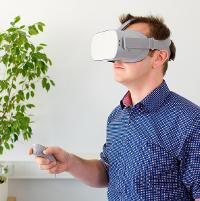In the context of global calls for society-wide initiatives to foster healthy ageing, technology is often implicated as an enabling feature of age-friendly environments. A recent review described technologies intended to help older people ‘age in place’, i.e. continue living as independently as possible in their chosen home. These included computer systems to aid in communication and potentially reduce loneliness, wearable alarms to call for emergency assistance, tools to encourage physical activity such as pedometers and online exercise platforms, and devices for monitoring mental well-being such as a neurofeedback headband used with mindfulness training. Technological innovation to support healthy ageing extends beyond the health sphere, encompassing financial and social aspects of life alongside health-focused domains such as illness prevention and mobility.
While the global impacts of the 21st century technological revolution cannot be denied, not everyone shares enthusiasm for it. Debates on the benefits or harms of technology go back centuries, with current tensions surrounding the ‘Fourth Industrial Revolution’ centred on large-scale robotics in factory production and machine learning within service industries, including artificial intelligence applications within healthcare. Following severe restrictions to in-person health services during the COVID-19 pandemic, the use of remote consultation and health monitoring through electronic platforms (‘digital health’) rose substantially, along with concerns about heightening inequalities across the digital divide. Anthropologists have cautioned against uncritical technological adoption, emphasizing the importance of understanding how different people employ technologies in specific contexts.
Within these ongoing debates, the idea that people are empowered through technology – for example, to live more easily with a disability – has been advocated. But there is disagreement about what empowerment is and how technology should foster it (if at all, noting the potential for unintended consequences such as cyber abuse). England’s National Health Service (NHS) explicitly promotes empowering patients through digital tools and information-sharing platforms. This neoliberal framing of empowerment – heavily emphasizing individual choice, control, and self-determination – has been criticized for pressuring people to ‘take personal responsibility’ for their own health while denying the macro-level, health-influencing forces over which individuals have little control. A different formulation of empowerment draws on Sen’s capability approach to emphasize inclusion and social participation, which can counteract societal-level discrimination including ageism.
In a recent project I wrestled with these various notions of empowerment while observing the use of virtual reality (VR) technology in care homes. The developers of the technology (ROVR Systems) offer VR content through a wireless headset, which can be linked to devices that prompt movement in the virtual environment (either a standing treadmill, or a mat to use when seated). The project was pitched in response to the physical deconditioning experienced by many care home residents during the COVID-19 lockdowns. The idea was that the VR content, which includes both digitally animated scenes and filmed footage from places around the world, would be stimulating in its own right and would motivate people to do ‘unwitting exercise’ in order to explore the virtual worlds. The technology also has a social component, with multiple users able to interact within a selected virtual environment at the same time.
While the ROVR technology had been tested in public road shows that included older people, we went into this project not knowing if care home residents would want to engage with VR, or what (if any) benefit they might get from it. There were also feasibility issues around how much support residents would need to use the technology, and if care home staff would have the willingness and capacity to support VR use alongside their many daily responsibilities. The integral role of care staff for enabling residents’ engagement with the technology – particularly residents living with varying forms of cognitive impairment – was highlighted early on. During the first session that I observed, one carer escorted the resident into the space where the VR system was set up and observed to ensure safety and comfort, while a second carer verbally engaged with the resident while navigating the VR content on the tablet. The first three residents to try the VR headset had very different reactions: one was very keen to talk about what he had seen but had limited concentration and did not stay in the virtual environment for long, one tried the headset briefly with encouragement from care staff but then asked to stop, and the third exclaimed ‘Oh wow!’ immediately and enjoyed a long session viewing multiple VR scenes.
As the project progressed and more residents were introduced to the VR technology, the potential social benefits were clear. Conversations ensued (with encouragement from project team members) about residents’ experiences of the virtual worlds, which sparked reminiscence for some about places where they’d lived or visited. The most enthusiastic residents encouraged others to try VR, with a few even taking over the tablet to select the content for their friends. Social engagement continued when the movement element was introduced, with residents encouraged to describe what they saw as they ‘walked’ (sliding their feet on a portable mat from a seated position) in the virtual environment. Feedback on the distance covered was motivating for some residents, who pushed themselves to ‘walk’ further than last time or further than their peers. Care home staff fed back that the level of engagement was exceptionally high for some residents, although on any given day the numbers varied, with quite a few declining to participate or observing only. Residents with physical impairments seemed to especially enjoy and benefit from the virtual walking experience, as their ability to go on real-world walks was very limited. For them the VR technology did seem to provide ‘the world at your feet’, as promoted by the technology developers.
Can we say that the use of VR technology was empowering for these care home residents? The neoliberal sense of empowerment, with digital technology enabling more choice and control over one’s healthcare, seems a difficult fit in this context. While care home staff encouraged participation and choice from residents as far as possible, responsibility for the daily flows of care (ensuring everyone was well fed, comfortable, and receiving any needed medication) lay with the professionals. Time to engage with the VR technology was structured as an externally-provided part of the care homes’ overall activities programmes, with participation prompted by staff rather than requested by residents. But residents maintained autonomy in the moment; while strong encouragement from staff was sometimes needed for residents to try VR in the first place, a refusal was always respected, and those who did engage set the terms for how long and in what ways they took part. The novelty of the experience and the VR-prompted opportunity to ‘walk’ somewhere different was clearly appreciated by some residents, who demonstrated their enjoyment by taking part in the VR sessions repeatedly over several months. In reflecting on my observations of these sessions, I suggest that the capabilities approach to empowerment is more appropriate for considering what role new technology could play in care homes; while the experience of VR might not influence care decisions, it potentially fosters skill-building and new forms of social engagement.
Empowerment through technology is a tricky issue in the context of long-term care. Schicktanz and Schweda consider the ethics of technology-assisted care for older people, distinguishing between ‘power over’ (domination) and ‘power to’ (enhancing capacity and human agency) in the relational dynamics at play when introducing new technologies. Technologies that allow for continuous monitoring or real-time data capture could be seen as ‘power over’ individuals that potentially clash with rights of self-determination and privacy. Conversely technologies that allow for knowledge exchange or new experiences may be seen more positively as giving ‘power to’ learn, to access services more easily, or to be seen and heard through new modes of communication. I consider the use of VR technology by care home residents to be more the latter, but there is always potential for the former depending on what data new technologies generate and who has access to them. I am left still wrestling with the ambiguous potential of technology to empower older people, noting Kaplan and colleagues’ observation that “at the center of the intervention equation is not the technology itself, but the quest for tapping into the relationship-enhancing potential of the technology.”
About the Authors:
Dr Caroline Potter is a Senior Research Fellow in Health and Social Care at the Oxford Institute of Population Ageing.
Opinions of the blogger is their own and not endorsed by the Institute
Comments Welcome: We welcome your comments on this or any of the Institute's blog posts. Please feel free to email comments to be posted on your behalf to administrator@ageing.ox.ac.uk or use the Disqus facility linked below.













